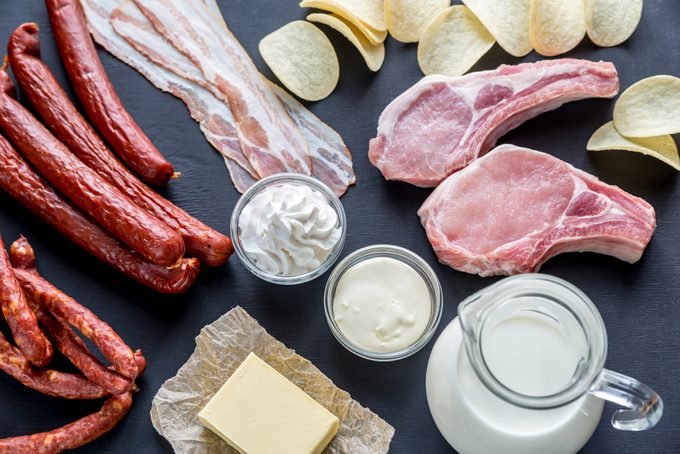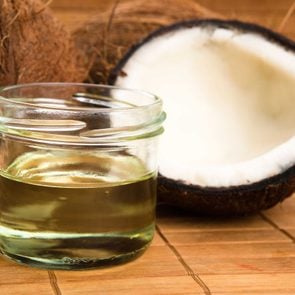What Is Saturated Fat?
Updated: Mar. 11, 2022
When it comes to nutrition, saturated fats are still considered relatively unhealthy fats. But if you are cutting back, it's important to swap them for healthier fats.
How to lower your cholesterol level
In the hierarchy of good and bad fats, saturated fat usually occupies a place toward the unhealthy end of the spectrum. That’s because saturated fat increases low-density lipoprotein (LDL), the so-called “bad” cholesterol.
High cholesterol is strongly implicated in heart disease, including heart attacks, explains Benjamin Hirsch, MD, director of preventive cardiology at Northwell Health’s Sandra Atlas Bass Heart Hospital in Manhasset, New York.
That’s a concern for pretty much all adults, considering how prevalent cardiovascular disease is. It’s the top cause of death among both men and women in the United States.
You’d think limiting saturated fat would be the solution. But the key to healthy living is to also replace saturated fats with unsaturated fats. These healthy fats are linked with lower levels of LDL and a similarly lower risk of cardiovascular disease.

Types of fat
Fats are generally grouped into three main types—unsaturated, saturated, and trans—based on the molecular structure of the compound.
All fats are basically made up of carbon atoms with long “tails,” or chains of hydrogen atoms attached to them. The more hydrogen molecules, and the more crowded the chain is, the less healthy the fat.
Trans fats and saturated fats have a lot of hydrogen molecules, which makes them rigid and helps explain why they tend to be solid at room temperature. (Think of butter and congealed bacon grease.)
Unsaturated fats, which include monounsaturated or polyunsaturated, have fewer hydrogen attachments, are less rigid, and tend to be liquid at room temperature. Case in point: olive or canola oils.
As far as healthfulness goes, the three types of fat occupy a range:
- Unsaturated fats: They’re good for your health and are an important part of a healthy diet.
- Trans fats: These have essentially no redeeming qualities in terms of your health. In fact, they’ve been banned in some locations, like the United States.
- Saturated fats: They occupy a position somewhere in between and their role in heart health has been debated.
Why do we need fat?
In a nutshell, we all need a certain amount of fat to stay alive.
“Fat helps the body absorb vitamin A, vitamin D, and vitamin E. These vitamins are fat soluble, which means they can only be absorbed with the help of fats,” says Lana Nasrallah, RD, manager of clinical nutrition at the University of North Carolina Medical Center in Chapel Hill.
Fats also pack more calories than carbohydrates and proteins, which means they provide a lot of energy, or fuel, for your body, she says. In other words, you get a lot of bang for your buck.
How fat plays a role in inflammation
Not only do unsaturated fats improve cholesterol levels, but they also ease inflammation, which is a major contributor to heart disease, cancer, and chronic illnesses like diabetes.
Saturated fats, on the other hand, can stimulate inflammatory molecules. “That makes the artery walls more permeable to fat deposits,” says Dr. Hirsch.
And in addition to raising cholesterol levels to unhealthy heights, saturated fats are generally high in calories.
“It’s easy to overdo caloric intake, which can lead to weight gain,” says Debbie Petitpain, RDN, a spokesperson for the Academy of Nutrition and Dietetics. More pounds on your frame equals a higher risk of, well, almost everything.
Saturated fats are still being studied
“Fat, in general, is a huge category, and it’s incredibly nuanced,” says Josh Septimus, MD, an internist and associate professor of clinical medicine at Houston Methodist Hospital. “There are definitely healthy fats, like olive oil [which is unsaturated], and unhealthy fats, like trans fats.”
But there may be much more in between than we realize.
One analysis of 21 studies published in The American Journal of Clinical Nutrition in 2010 found that consuming more saturated fat was not linked with an increased risk of stroke, coronary heart disease, or cardiovascular disease. This suggests that while saturated fat can increase LDL cholesterol, their final impact on actual heart attacks and strokes still needs to be clarified. However, other research has suggested that replacing saturated fat with polyunsaturated fat does lower the risk for heart problems.
At a chemical level, the differences may have to do with how long the fat chains are. “Short-, medium-, long-, and very-long-chain fats all have different effects on health,” says Nasrallah.
Coconut oil, a saturated fat, may fall into this gray area. For now, though, coconut oil and other saturated fats are considered just that: saturated fats.
“The future could refine our advice a little bit more,” says Petitpain.
How much saturated fat should you consume?
Experts advise curbing saturated fat intake. The 2015–2020 Dietary Guidelines for Americans recommends limiting saturated fat to 10 percent of daily calories. (Overall, fat should make up 20 to 35 percent of daily calories).
The American Heart Association (AHA), which is understandably concerned about the current epidemic of heart disease, sets the bar lower, at only 5 to 6 percent of total calories each day. In general, the lower the better, says Dr. Hirsch.
Per the AHA guidelines, says Nasrallah, “if you need about 2,000 calories a day, no more than 120 calories should come from saturated fat. That’s about 13 grams of saturated fat per day.”
Limit saturated fats
When you open your refrigerator or cupboard door, you’re not likely to see anything clearly labeled “saturated” or “unsaturated.”
Most foods have some of both, although animal-based foods are typically higher in saturated fat, while plant-based foods are typically higher in unsaturated fats. The Mediterranean diet is a good model for an eating plan high in healthy fats.
One way to make sure you’re eating the right type of fats is to read the nutrition label on foods that you buy. It will give you total fat, saturated fat, and trans fat in both grams and as a percentage of daily calories. A daily value of 5 percent or less is low, while 20 percent is very high, says Petitpain.
And consider this: A 12-ounce steak has 20 grams of saturated fat. A cheeseburger has 10 grams. A vanilla shake has 8 grams. And a tablespoon of butter has 7 grams.

Sources of saturated fat
It’s best to limit your intake of the following foods, which Nasrallah names as high in saturated fat.
- Butter
- Whole or reduced fat milk and dairy (look for skim or 1 percent), including ice cream
- Lard
- Bacon
- Fatty beef
- Poultry with skin
- Lamb
- Pork
- Chips and other “munchies”
- Coconut, palm kernel, and palm oils
Swap saturated for unsaturated
Cutting back on saturated fats only goes so far.
“The best strategy is not to just limit saturated fats,” says Nasrallah. “It is also to replace them with healthier unsaturated fats. That has more heart health benefits than cutting down or replacing them with foods of little nutritional value, like refined carbohydrates packed with added sugar.”
Sources of healthy unsaturated fats include:
- Non-tropical vegetable oils, such as olive, canola, safflower, sunflower, soybean, and peanut oils
- Nuts, including walnuts, pecans, and almonds
- Seeds, like pumpkin, sesame, and flaxseed
- Avocado
- Fish
Try to limit processed food
There is a simpler way to look at it, which has nothing to do with counting fats, saturated or otherwise.
“We should be focusing on reducing ‘fake’ food,” says Dr. Septimus. By that he means the refined, processed foods that drive up systematic inflammation and raise the risk for cardiac and many other diseases.
That includes some of the most popular items around.
“In the United States, the biggest sources of saturated fat in the diet are pizza, cheese, dairy-based desserts, whole milk, butter, sausage, bacon, beef, hamburger, cookies, and a variety of fast food dishes,” says Nasrallah.
It helps to concentrate your energies on eating unprocessed, whole foods. “If you see ingredients on a label that your great-great-grandmother wouldn’t recognize, don’t buy it,” Dr. Septimus says.
Helpful tips for lowering saturated fat
“You can still have some foods and beverages with saturated fats, just choose smaller portions or have them less often,” says Nasrallah.
Here are some healthy substitutions for saturated fats:
- Choose lean meat and skinless poultry. Trim visible fat from meat and remove the skin from poultry.
- Use oil (top choices are olive and canola) instead of butter.
- Eat fatty fish instead of meat at least twice a week. Oily fish (salmon, tuna, and mackerel) are also rich in omega-3 fatty acids, a type of heart-healthy polyunsaturated fat.
- Favor fruits and vegetables over processed foods
Other unsaturated fats you can choose from include olives, avocados, nuts, chia seeds, and flaxseeds. Feeling hungry yet? Now would be a good time to whip up an avocado salad, olive tapenade, sweet-and-tangy salmon, or a spiced nut trail mix.
















